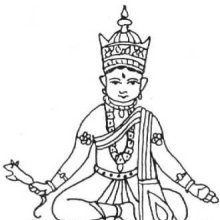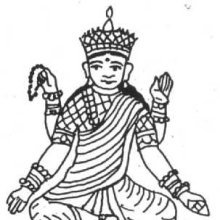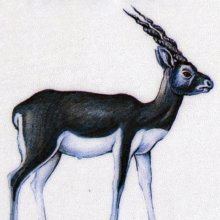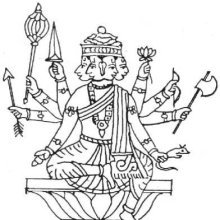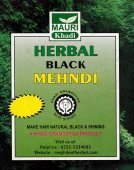Black: 3 definitions
Introduction:
Black means something in Hinduism, Sanskrit, Hindi. If you want to know the exact meaning, history, etymology or English translation of this term then check out the descriptions on this page. Add your comment or reference to a book if you want to contribute to this summary article.
Images (photo gallery)
(+23 more images available)
In Hinduism
Natyashastra (theatrics and dramaturgy)
Source: Shodhganga: Elements of Art and Architecture in the Trtiyakhanda of the Visnudharmottarapurana (natya)1) The Black colour (in Indian Dramas) is reserved for Vāsuki, as conveyed through the Aṅgaracanā division of Āhāryābhinaya: one of the four divisions of Abhinaya or “ways to convey or represent one’s emotion to others”, according to the Viṣṇudharmottarapurāṇa, an ancient Sanskrit text which (being encyclopedic in nature) deals with a variety of cultural topics such as arts, architecture, music, grammar and astronomy.—Aṅgaracanā meaning painting of limbs of different characters, also falls under the category of makeover. The Viṣṇudharmottarapurāṇa speaks that it should be done according to the caste, position, superiority and country of respective characters. As for example, this book suggests that Vāsuki should be black in colour; [...] etc. The Nāṭyaśāstra also agrees on it. This is important to note that this type of notes and rules give a social implication of the performance.
2) The Black (colour) is denoted by the Sanskrit word Kṛṣṇa and is associated with Bhayānaka or the “terrible sentiment”, which represents one of the nine kinds of Rasa (“soul of Drama”), according to the Viṣṇudharmottarapurāṇa.—According to the Viṣṇudharmottarapurāṇa bhayānaka is the sentiment of fear which arises from the commitment of a self committing offence. Bhaya i.e., fear is the sthāyibhāva of bhayānakarasa. Kṛṣṇa i.e black is the colour and Kāladeva is the God of this sentiment.
3) The Black color is associated with Catura-hasta: one of the twenty-two Single-hand Gestures (in Indian Dramas).—According to the Viṣṇudharmottarapurāṇa, some colours are pointed with the catura hand gesture. When the hand is raised in catura posture, it denotes white colour. When the hand moves in circular way and in semi-circular motion in caturahasta, it denotes yellow and red colour respectively. In compacted form it shows blue colour. When the hand is kept in normal position with caturahasta, it denotes black and the other remaining colours.

Natyashastra (नाट्यशास्त्र, nāṭyaśāstra) refers to both the ancient Indian tradition (shastra) of performing arts, (natya—theatrics, drama, dance, music), as well as the name of a Sanskrit work dealing with these subjects. It also teaches the rules for composing Dramatic plays (nataka), construction and performance of Theater, and Poetic works (kavya).
Shilpashastra (iconography)
Source: Shodhganga: Elements of Art and Architecture in the Trtiyakhanda of the Visnudharmottarapurana (shilpa)1) Black (colour) is denoted by the Sanskrit term Kṛṣṇa and represents one of the five primary colours in the ancient Indian tradition of Painting (citra), according to the Viṣṇudharmottarapurāṇa, an ancient Sanskrit text which (being encyclopedic in nature) deals with a variety of cultural topics such as arts, architecture, music, grammar and astronomy. In the Viṣṇudharmottarapurāṇa, five colours are regarded as the primary ones, e.g., Black (kṛṣṇa). Mixing of colours is a great technique used by the artists to make numerous shades of colours. A painter can create hundreds or thousands of colours by amalgamating the primary ones.
2) The Black color is associated with various deites.—In the Viṣṇudharmottarapurāṇa, the attire, accessories, weapons, carrier, different colours etc. of the idols of different deities are projected which are taken for discussion here. It is clear that the book offers a great field of knowledge regarding the nuances of Indian art of Image making [e.g., the various colours for garments] during 10th–11th century A.D.
Black colour of Yama’s complexion.—According to the Viṣṇudharmottarapurāṇa, the colour of the image of Yama should be very dark like water loaded cloud. The Kāśyapaśilpa also states that the complexion of Yama should be as dark as black colour.[24] Śilparatna of Śrīkumāra also admits it.
Black colour of Varuṇa’s cloth.—Varuṇa is known as the lord of water. In the Śatapaṭhabrāhmaṇa, the god Varuṇa is said to be adorned with black cloth. It is also stated that if black one is not obtained then any kind of cloth is recommended for Varuṇa. The perception of later works on Iconography is totally different from the Śatapaṭhabrāhmaṇa in this context. [...]

Shilpashastra (शिल्पशास्त्र, śilpaśāstra) represents the ancient Indian science (shastra) of creative arts (shilpa) such as sculpture, iconography and painting. Closely related to Vastushastra (architecture), they often share the same literature.
Languages of India and abroad
Hindi dictionary
Source: DDSA: A practical Hindi-English dictionaryBlack in Hindi refers in English to:—(a) black; ~[borda] black-board; ~[marketa] the black market; —[ka paisa] black money..—black (ब्लैक) is alternatively transliterated as Blaika.
...
See also (Relevant definitions)
Starts with (+142): Black alder, Black antelope, Black arum, Black ash, Black babool, Black bead, Black bean, Black bean tree, Black bearberry, Black bee, Black beniseed, Black benniseed, Black berry, Black berry nightshade, Black birch, Black bird, Black bird-berry, Black bitterberry, Black blossom berry, Black Buddhist.
Ends with: Katho black, Shoe black.
Full-text (+4701): Krishna, Krishnasara, Krishnavarna, Krishnajina, Asita, Sitasita, Kalaka, Sitetara, Karshna, Mecaka, Shyama, Dipakitta, Atijagara, Bhramara, Shyamala, Krishnadeha, Nila, Priyangu, Siti, Kalaguru.
Relevant text
Search found 345 books and stories containing Black; (plurals include: Blacks). You can also click to the full overview containing English textual excerpts. Below are direct links for the most relevant articles:
Nadine Gordimer < [October – December 1991]
Tony Morrison -Nobel Laureate of 1993 < [January – March, 1994]
The Dialectics of Racism: Amiri Baraka’s < [January – March, 1994]
Rig Veda (translation and commentary) (by H. H. Wilson)
A Collection of Popular Tales from the Norse and North German (by Peter Christian Asbjørsen)
The Literature of the Ancient Egyptians (by E.A. Wallis Budge)
Chapter VIII - Historical Literature
Chapter IX - Autobiographical Literature
The Linga Purana (by J. L. Shastri)
Chapter 14 - Origin of Aghora < [Section 1 - Uttarabhāga]
Chapter 23 - Various Kalpas < [Section 1 - Uttarabhāga]
Chapter 17 - Origin of the Liṅga (liṅgodbhava) < [Section 1 - Uttarabhāga]
Bhagavati-sutra (Viyaha-pannatti) (by K. C. Lalwani)
Part 9 - On tinges (leśyā) < [Chapter 2]
Chapter 10: On tinges < [Book 4]
Part 5 - On the span of existence of molecule of matter < [Chapter 7]
Related products
(+85 more products available)

